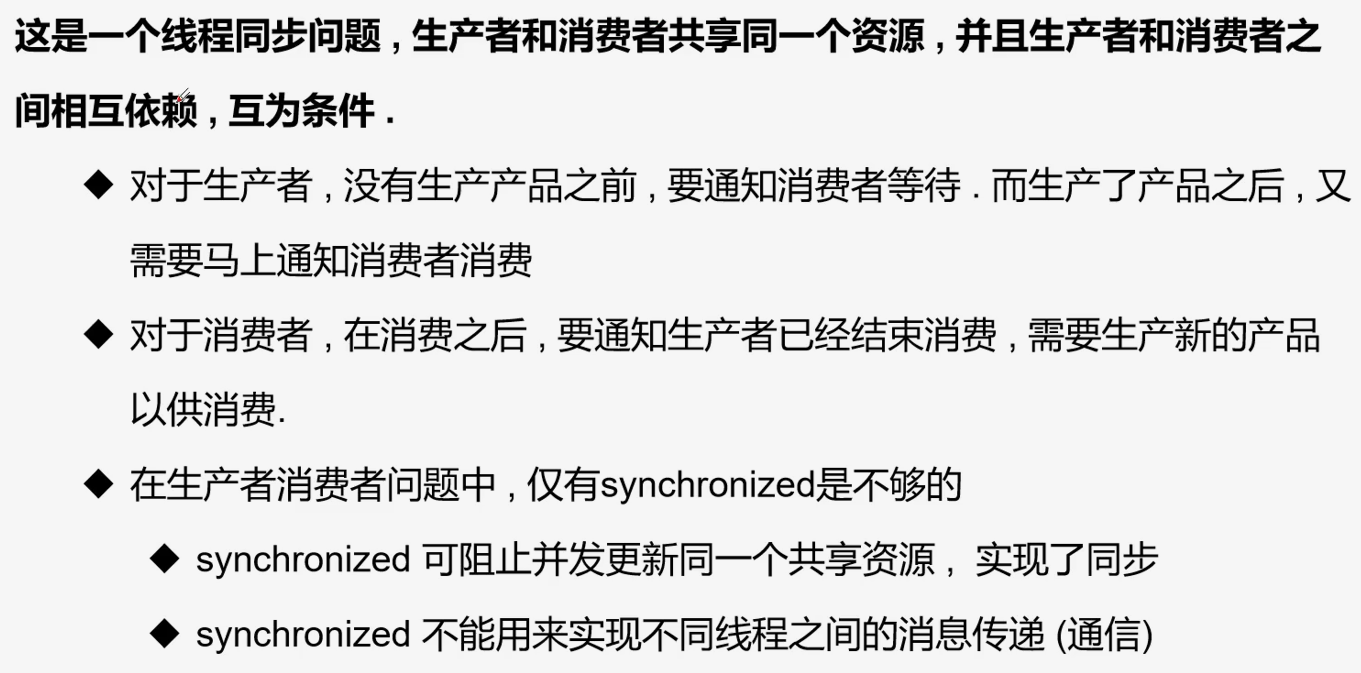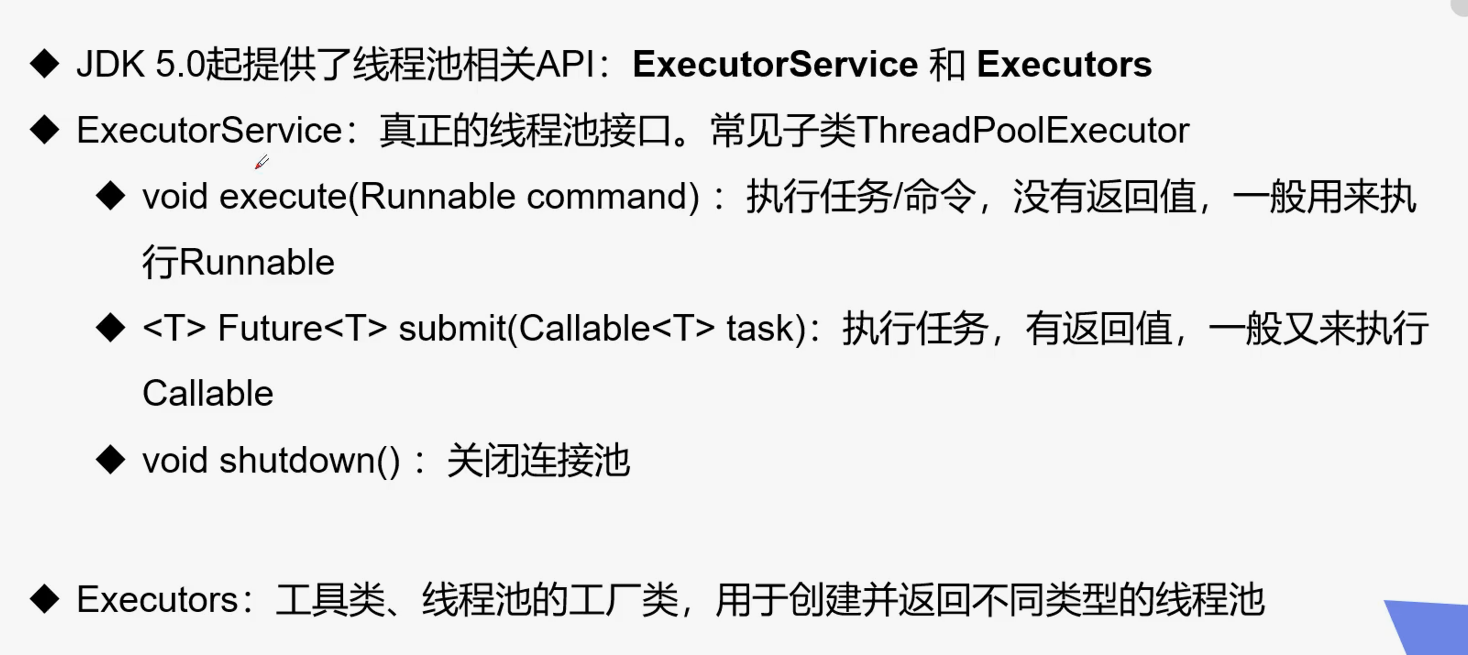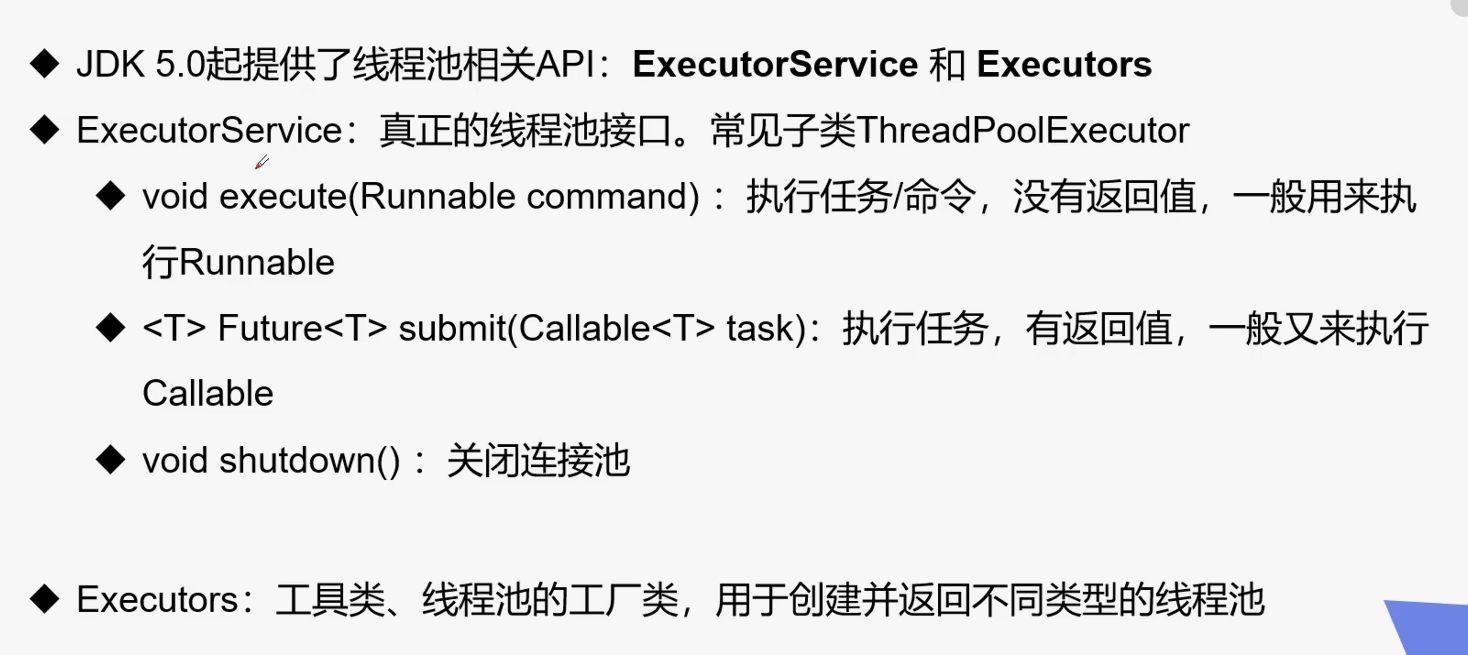线程协作 线程通信 线程池
## 1.4 线程协作
生产者消费者模式
应用场景:生产者和消费者问题
- 假设仓库中只能存放一件产品,生产者将生产出来的产品放入仓库,消费者将仓库中产品取走消费.
- 如果仓库中没有产品,则生产者将产品放入仓库,否则停止生产并等待,直到仓库中的产品被消费者取走为止.
- 如果仓库中放有产品﹐则消费者可以将产品取走消费﹐否则停止消费并等待,直到仓库中再次放入产品为止.


#### 线程通信

#### 解决方式一:
并发协作模型“生产者/消费者模式”--->管程法
- 生产者:负责生产数据的模块(可能是方法﹐对象﹐线程,进程);
- 消费者:负责处理数据的模块(可能是方法﹐对象,线程,进程);
- 缓冲区:消费者不能直接使用生产者的数据﹐他们之间有个“缓冲区“
生产者将生产好的数据放入缓冲区,消费者从缓冲区拿出数据
```java
package com.zishi.lesson4;
//测试:生产者消费者模型-->利用缓冲区解决:管程法
//生产者, 消费者, 产品, 缓冲区(库存)
public class TestPC {
public static void main(String[] args) {
SynContainer container = new SynContainer();
new Productor(container).start();
new Consumer(container).start();
}
}
//生产者
class Productor extends Thread{
SynContainer container;
public Productor(SynContainer container) {
this.container = container;
}
//生产
@Override
public void run() {
for (int i = 1; i <= 100; i++) {
System.out.println("------生产了第"+i+"只鸡");
container.push(new Chicken(i));
}
}
}
//消费者consumerCustomer
class Consumer extends Thread{
SynContainer container;
public Consumer(SynContainer container) {
this.container = container;
}
//消费
@Override
public void run() {
for (int i = 1; i <= 100; i++) {
System.out.println("消费了第"+container.pop().id+"只鸡");
}
}
}
//产品
class Chicken{
int id;//编号
public Chicken(int id){
this.id = id;
}
}
//缓冲区
class SynContainer{
//需要一个容器大小
Chicken[] chickens = new Chicken[10];
//容器计数器
int count = 0;
//生产者放入产品
public synchronized void push(Chicken chicken){
//如果容器满了,就需要等待消费者消费
if (count==chickens.length){
//通知消费者消费,生产者等待
try {
this.wait();
} catch (InterruptedException e) {
e.printStackTrace();
}
}
//如果容器没有满,就需要放入产品
chickens[count] = chicken;
count++;
//通知消费者消费
this.notifyAll();
}
//消费者消费吃鸡
public synchronized Chicken pop(){
//判断是否可以消费
if (count==0){
//等待生产者生产,消费者等待
try {
this.wait();
} catch (InterruptedException e) {
e.printStackTrace();
}
}
//如果可以消费
count--;
Chicken chicken = chickens[count];
//吃完了,通知生产者生产
this.notifyAll();
return chicken;
}
}
```
#### 解决方式二:
并发协作模型“生产者/消费者模式”--->信号灯法
标识位 来判断
```java
package com.zishi.lesson4;
//测试生产者消费者问题2:信号灯法,标志位解决
public class TestPc2 {
public static void main(String[] args) {
TV tv = new TV();
new Player(tv).start();
new Watcher(tv).start();
}
}
//生产者-->演员
class Player extends Thread{
TV tv;
public Player(TV tv) {
this.tv = tv;
}
@Override
public void run() {
for (int i = 0; i < 20; i++) {
if (i%2==0){
this.tv.play("小神龙俱乐部放映中");
}else {
this.tv.play("泰国广告");
}
}
}
}
//消费者-->观众
class Watcher extends Thread{
TV tv;
public Watcher(TV tv) {
this.tv = tv;
}
@Override
public void run() {
for (int i = 0; i < 20; i++) {
tv.watch();
}
}
}
//产品-->节目
class TV{
//演员表演,观众等待
//观众观看,演员等待
String voice;//表演的节目
boolean flag = true;
//表演
public synchronized void play(String voice){
if (!flag){
try {
this.wait();
} catch (InterruptedException e) {
e.printStackTrace();
}
}
System.out.println("演员表演了:"+voice);
//通知观众观看
this.notifyAll();
this.voice = voice;
this.flag = !this.flag;
}
//观看
public synchronized void watch(){
if (flag){
try {
this.wait();
} catch (InterruptedException e) {
e.printStackTrace();
}
}
System.out.println("观看了:"+voice);
//通知演员表演
this.notifyAll();
}
}
```
### 线程池
**背景:**经常创建和销毁、使用量特别大的资源,比如并发情况下的线程,对性能影响很大。
**思路:**提前创建好多个线程,放入线程池中,使用时直接获取,使用完放回池中。可以避免频繁创建销毁、实现重复利用。类似生活中的公共交通工具。
**使用线程池的好处:**
- 提高响应速度(减少了创建新线程的时间)
- 降低资源消耗(重复利用线程池中线程,不需要每次都创建)
- 便于线程管理(…..)
- corePoolSize:核心池的大小
- maximumPoolSize:最大线程数
- keepAliveTime:线程没有任务时最多保持多长时间后会终止
使用线程池
[外链图片转存失败,源站可能有防盗链机制,建议将图片保存下来直接上传(img-WZ6Ljr3v-1630852420618)(C:\Users\onefat\AppData\Roaming\Typora\typora-user-images\image-20210905221508309.png)]
```java
package com.zishi.lesson4;
import java.util.concurrent.ExecutorService;
import java.util.concurrent.Executors;
//测试线程池
public class TestPool {
public static void main(String[] args) {
//1.创建服务,创建线程池
//newFiexdThreadPool 参数位:线程池大小
ExecutorService service = Executors.newFixedThreadPool(10);
//执行
service.execute(new MyThread());
service.execute(new MyThread());
service.execute(new MyThread());
service.execute(new MyThread());
//2。关闭连接
service.shutdown();
}
}
class MyThread implements Runnable{
@Override
public void run() {
System.out.println(Thread.currentThread().getName());
}
}
```



